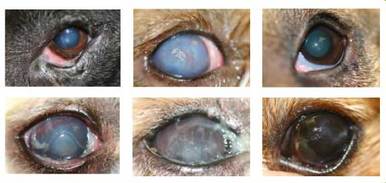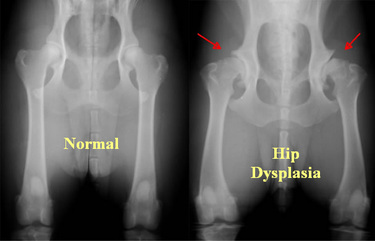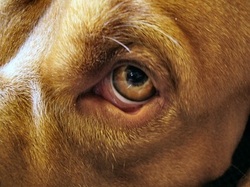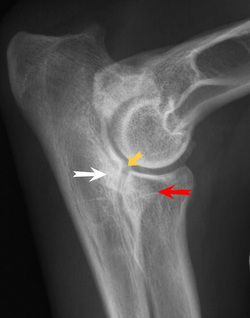
Keratoconjunctivitis sicca in Dogs
Sometimes called dry eye syndrome, Keratoconjunctivitis sicca (KCS) is characterized by a deficiency of aqueous tear film over the surface of the eye and in the lining of the lids. The result is severe drying and inflammation of the cornea (the transparent front part of the eye) and conjunctiva (the clear membrane that covers the sclera -- the white part of the eye).
This condition is relatively common in dogs, particularly cocker spaniels, bulldogs, Dachshund, West Highland White Terrier (Westie), Lhasa apsos, and shih-tzus. In addition, there is some suspicion that females may be more predisposed to KCS than males.
Symptoms and Types
- Excessive blinking
- Swollen conjunctival blood vessels
- Chemosis (swelling of the tissue that lines the eyelids and surface of the eye)
- Prominent nictitans (third eyelid)
- Discharge of mucus or pus from the eye
- Corneal changes (chronic disease) in the blood cells, with pigmentation and ulceration
- Severe disease can lead to impaired or complete loss of vision
Causes
- Immune-mediated adenitis (inflammation of a gland that is brought about by abnormal activity of the body's immune system) is most common, and is often associated with other immune-mediated diseases
- Congenital in pugs and Yorkshire terriers, sporadically in other breeds
- Neurogenic - disease of the central nervous system is occasionally seen after traumatic proptosis (eyes displaced from their sockets) or after a neurologic disease that interrupts the nerves of the tear gland
- Often a dry nose on the same side as the dry eyes
- Drug induced - general anesthesia and atropine cause transient dry eye syndrome
- Drug toxicity - some sulfa-containing drugs or etodolac (an NSAID) may cause transient or permanent condition
- Physician induced - removal of the third eyelid may lead to this condition, especially in at-risk breeds
- X-Ray induced – can occur in response to the eye coming into close contact with a primary beam from a radiology device
- Systemic disease - canine distemper virus
- Chlamydia conjunctivitis - bacterial
- Chronic blepharoconjunctivitis – long term inflammation of the conjunctiva (lining of the eyeball and lids) and eyelids
- Breed-related predisposition
Diagnosis
Your veterinarian will perform a thorough physical and ophthalmological exam on your dog, taking into account the background history of symptoms and possible incidents that might have led to this condition. A Schirmer tear test can be used to measure tear values and the amount of wetness on the eye; that is, the amount of tear production that is taking place in the tear ducts and the amount available for the eye. A low value would be indicative of keratoconjunctivitis sicca. A fluorescein stain, a non-invasive dye that shows details of the eye under blue light, can be used to examine your dog's eye for abrasions/ulcerations. Your doctor may also take a sample of the aqueous fluid for culture, in order to determine how severe bacterial growth is in the eye and whether there is an infection that is underlying the KCS.
Treatment
Unless there is a secondary disease that calls for hospitalization, your dog will be treated on an outpatient basis. Topical medications, such as artificial-tear medication and possibly a lubricant can be prescribed and administered to compensate for your dog's lack of tears. You will need to be sure to clean your dog's eyes before you administer the medication, along with keeping the eyes clean and free of dried discharge. Some patients with KCS are predisposed to severe corneal ulceration, so you will need to call your veterinarian at once if the pain increases so that it can be treated before serious injury occurs.
Your veterinarian will probably also prescribe a topical antibiotic to be placed on the eye, either to treat a bacterial infection or as a preventative, and a topical corticosteroid or cyclosporine (an immunosuppressant drug that reduces the activity of a patient’s immune system) can be used for treatment of inflammation and swelling. Other medications may be prescribed depending on the underlying diseases that have brought on this syndrome.
A surgical procedure called parotid duct transposition may be used to reroute the parotid duct. This procedure reroutes the aqueous ducts in such a way that saliva can be used to compensate for the lack of tears, delivering fluid to the inferior conjunctival cul-de-sac. It’s performed much less frequently since cyclosporine was introduced. Saliva can be irritating to the cornea; some patients are uncomfortable after surgery and require ongoing medical therapy.
Living and Management
Your veterinarian will want to recheck your pet at regular intervals to monitor response and progress. The Schirmer tear test will probably be performed again four to six weeks after initiating cyclosporine to evaluate response. Your dog should have received the drug the day of the visit. Immune-mediated diseases usually require life-long treatment. Other types of disease may be transient and may require treatment only until tear production returns.




 RSS Feed
RSS Feed
